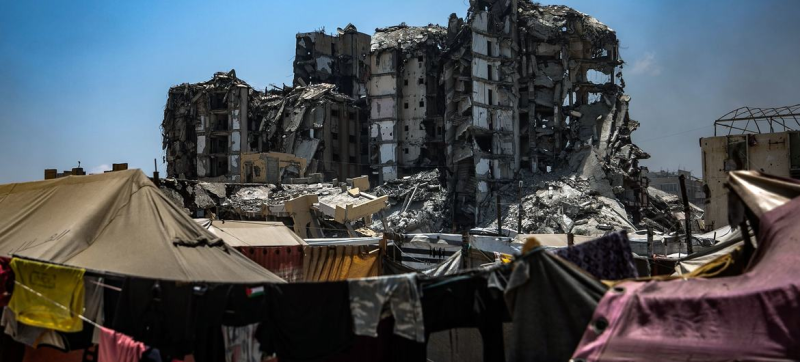- UN Report Calls for New Thinking to Secure a Sustainable Future |
- BNP moves to finalise seat sharing as alliance friction grows |
- BNP plans universal 'Family Card' for all women: Tarique Rahman |
- Tangail saree weaving gets recognition as intangible cultural heritage |
- Chuadanga farmers thrive as cauliflower yields hit new high |
Gaza Health Crisis Deepens as Hospitals Overflow, WHO Warns

Familes in Gaza are living in tents amongst the ruins of their former homes.
Public health conditions in Gaza are “catastrophic,” with hospitals operating far beyond capacity. Some life-saving medicines are completely out of stock, while deaths from malnutrition and disease are on the rise, the UN health agency warned on Tuesday.
Fewer than half of Gaza’s hospitals and under 38 per cent of primary healthcare centres are partially functioning—or are doing so at minimal levels—said Dr. Rik Peeperkorn, World Health Organization (WHO) Representative for the West Bank and Gaza.
Bed occupancy in major facilities is exceeding limits by large margins—Shifa Hospital is at 250 per cent capacity, Nasser at 180 per cent, Al-Rantisi at 210 per cent, and Al-Ahli at over 300 per cent.
“The critical shortage of medications and consumables continues and has only worsened, with 52 per cent of medicines and 68 per cent of consumables at zero stock,” Dr. Peeperkorn told journalists in Geneva, speaking from Jerusalem.
“Hospitals are particularly overwhelmed by injuries from food distribution areas, which are also driving persistent shortages of blood and plasma,” he added, noting that since 27 May, at least 1,655 people have been killed in those areas and more than 11,800 injured.
The crisis has been worsened by displacement orders in Gaza City that now place WHO’s own warehouse in an evacuation zone. Hospitals, primary care centres, and ambulance facilities are also located inside or near these areas, threatening further disruption to services.
Hunger and malnutrition are rapidly worsening.
Since the start of 2025, 148 people have died from malnutrition, including 49 children—39 of them under five years old. Nearly 12,000 children under five were diagnosed with acute malnutrition in July, the highest monthly figure to date, with more than 2,500 suffering from the most severe form.
Disease outbreaks are adding to the pressure.
Suspected meningitis cases reached 452 between July and early August—the highest number since the escalation began. Guillain-Barré syndrome, a rare post-infection disorder, has also surged, with 76 suspected cases since June.
Both conditions are harder to treat due to “zero stocks” of vital medicines, including intravenous immunoglobulin and anti-inflammatories, Dr. Peeperkorn said.
Access for international medical teams and supplies remains a major obstacle.
Dr. Peeperkorn said that international medics face entry denials, while key items such as ICU equipment, anaesthesia machines, and cold chain supplies continue to be held back.
Though WHO managed to bring in 80 trucks of medical supplies since June, he stressed that procedures are slow and unpredictable, with many shipments delayed or denied.
“We need multiple crossings into Gaza opened, procedures simplified, and access impediments lifted,” he said. “We hear about more humanitarian supplies being allowed in—but it’s not happening, or it’s happening far too slowly.”

